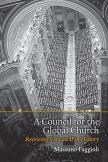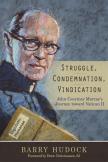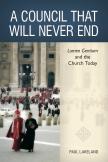Vatican II: The Next 50 Years
Anticipating the 50th anniversary of the completion of the Second Vatican Council (Dec. 8, 1965), theologians have ramped up their output with timely commentaries that probe, stretch and advance the event that transformed the church and boldly propelled it into the modern era. Not since the golden age of Catholic publications, 1965–75, have we seen so much interest.
Perhaps only three other ecumenical councils out of the 21 have had as much impact as Vatican II—the first, Nicaea, in 325, called by the Emperor Constantine to settle disputes in the empire about the salvific role of Christ; Chalcedon, in 453 to clarify the person and nature of Christ; and Trent, 1545–63, to reform the church, define key doctrines and respond to the Protestant Reformation.
Each of these current books convincingly underscores the unfinished business of Vatican II and delves into the arguments and events that characterized the intense, dynamic debates that marked the council up to and during its four sessions.
Massimo Faggioli carries a high profile as a church historian. As a scholar now located at St. Thomas University, in St. Paul, Minn., he was intimately involved with the Bologna Project, which produced the multilingual five volumes of what is likely to be the definitive history of the Second Vatican Council—all its documents, interventions, speeches and initial commentaries. The actual history, as opposed to subsequent, sometimes skewed interpretations, broadens the scope of the council beyond the seminal 16 documents to include the driving force, the spirit and the larger intent of the council. It gives the context of the debates and clearly situates the council, as an event, not simply as a collection of important documents.
Faggioli’s strength is that he clearly identifies the theological issues that need to be advanced, especially as the shift from Eurocentric Catholicism to global Catholicism takes hold. He tantalizes the reader by leaving the task for others to do—or perhaps he has simply outlined his own projects for the next decade.
Barry Hudock expertly narrates the intriguing and tortured history of the arguments of John Courtney Murray, S.J., for religious liberty that led directly to the council’s “Declaration on Religious Freedom.” As Hudock’s title, Struggle, Condemnation, Vindication, suggests, Murray valiantly threaded his way through the multiple obstacles posed by his theological adversaries, primarily the American theologians Francis Connell and Joseph Fenton, and the formidable Cardinal Alfredo Ottaviani of the Holy Office.
Murray’s thesis ingeniously asserted that the religious liberty provided by the U.S. Bill of Rights has its roots in the Catholic natural law tradition. The American cardinals eventually brought Murray to the council as an expert (peritus), and the document on religious liberty became the singular American contribution to the universal church. By all accounts Murray was brilliant. Even one of his critics acknowledged Murray’s “impressive erudition, remarkable dexterity, and uncommon command of language.”
Hudock captures the intellectual fervor and the huge stakes in the battle. He lifts the curtain to reveal some of the machinations during the council to derail the effort. The document on religious liberty was, after all, the clearest reversal of the teaching of Popes Gregory XVI and Pius IX, who had condemned freedom of religion, freedom of the press and the separation of church and state. Murray lived to see his vindication, though he died shortly after the council in 1967. At his funeral Walter Burghardt, S.J., affirmed, “Untold Catholics will never sense that they live so gracefully in this dear land because John Murray showed so persuasively that the American proposition is quite congenial to the Catholic reality.”
The most foundational book among the three is Paul Lakeland’s thorough examination of the “Dogmatic Constitution on the Church” (“Lumen Gentium”), in which he identifies the document’s multiple compromises and subsequent interventions by Pope Paul VI, which resulted in suspending some of the anticipated reforms of the church.
Lakeland’s book would have had a highly prophetic thrust if Pope Francis had not come on the scene just as he was finishing the manuscript. As it is, Lakeland’s theses provide a theological road map, with much of what Pope Francis has already so astutely started implementing.
Lakeland divides his treatise in three parts. The first describes in detail the council’s thrust toward episcopal collegiality, which was short-circuited by Paul VI when he abruptly established, under his own authority, a synod to gather every three years rather than a permanent structure. His successors John Paul II and Benedict XVI further undermined any authoritative leadership emerging from local churches. Under Pope Francis, however, collegiality is no longer a subject for argument. He has summoned a council of nine cardinals to assist him in major reforms. He generously incorporates insights from national conferences as integral to his own teaching. And he has mandated that the meetings of the Synod of Bishops on the family be a frank, open, even messy discussion of the vital issues.
The second part of Lakeland’s treatise unfolds the council’s breakthrough in establishing for the first time a theology of the laity, namely that all ministries among the people of God emerge from the baptism and the priesthood of the faithful.
However, once again in the post-conciliar period, the papacy and Roman curia thwarted a vigorous lay leadership by subordinating it to clerical leadership. Lakeland rhetorically asks whether lay ecclesial ministers are a theological monster. Are they simply a stand-in for priests, or is a genuine lay vocation emerging within these times? He queries, are they “apostles of the second string” or are they “heralds of a new conception of priestly ministry?”
Lakeland deftly traces all the ambiguities within this new ministry and suggests imaginative and theologically sound avenues for its resolution.
In the third and final section, “In Search of a Humbler Church,” Lakeland identifies humility as the antidote to many of our ecclesial ills that are products of the sin of exclusion. These include the invidious comparisons between the holy church and the sinful world, the empty comparisons between the fullness of truth in “our” tradition and the defects of others and the marginalization of others, whether they are divorced or gays and lesbians. Lakeland identifies this puritanical thrust of self-righteous purity as a revival of the ancient and dangerous heresy of Donatism.
Lakeland concludes with an extended reflection on the church as good Samaritan with three disquieting questions: Who is my neighbor, who is holy and who is the saint?
Each of these authors helps us to ponder the future of the church: Does the church have a wide, inclusive embrace? Does it encourage religious freedom as foundational for genuine belief? And is it committed to a vigorous, wide-open discernment about how the Spirit is guiding the church?
This article also appeared in print, under the headline “Vatican II: The Next 50 Years ,” in the October 26, 2015, issue.










